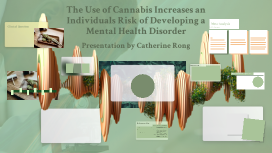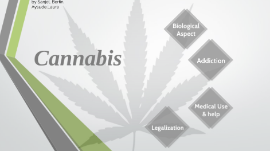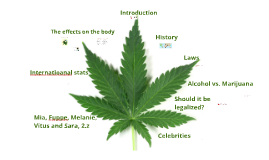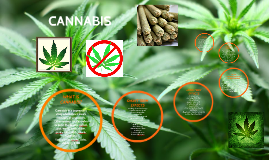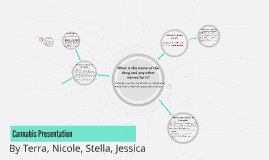Cannabis Presentation
Transcript: The Use of Cannabis Increases an Individuals Risk of Developing a Mental Health Disorder Meta-Analysis Clinical Question Article Summary Meta-Analysis Further Research Needs By Hannnah and Nicholas Myles and Matthew Large 6.3 YEARS In adolescents and young adults, does the use of cannabis increase the risk of developing mental health disorders compared to those who do not use cannabis? Cannabis use in the First Episode Psychosis: Meta-analysis of prevalence, and the time course of initiation and continued use (Myles et al., 2015). Interval between initiation of regular Cannabis use and age of onset of psychosis (Myles et al., 2015). Advocate: Routine Screening for detection of Cannabis use in metal health settings integrate substance abuse treatment into early psychosis intervention (Myles et al., 2015). Presentation by Catherine Rong Refining Literature Search Boolean Operators Limiters Phrase Searching Exclusion Terms Reference List: AND/OR Geographical Location ("Mental Health Disorders") NOT Age Range ("Cannabis Use Disorder") ("cannabis" OR "marijuana" OR "THC") AND ("mental health disorders" OR "psychiatric disorders" OR Articles Identified Date of Publishing ("adolescents" OR "teenagers" OR "youth") AND ("risk" OR "incidence" OR "prevalence") Glasheen, C., Forman-Hoffman, V. L., & Williams, J. (2017). Residential Mobility, Transience, Depression, and Marijuana Use Initiation Among Adolescents and Young Adults. Substance Abuse: Research and Treatment, 11, 117822181771141. https://doi.org/10.1177/1178221817711415 Hall, W. D. (2006). Cannabis use and the Mental Health of Young People. Australian & New Zealand Journal of Psychiatry, 40(2), 105–113. https://doi.org/10.1080/j.1440-1614.2006.01756.x Majid, S., Foo, S., Luyt, B., Zhang, X., Theng, Y.-L., Chang, Y.-K., & Mokhtar, I. A. (2019). Adopting evidence-based practice in clinical decision making: Nurses’ perceptions, knowledge, and barriers. Journal of the Medical Library Association : JMLA, 99(3), 229–236. https://www.ncbi.nlm.nih.gov/pmc/articles/PMC3133901/ Mathews, R. R. S., Hall, W. D., & Gartner, C. E. (2011). Depression and psychological distress in tobacco smokers and people with cannabis dependence in the National Survey of Mental Health and Wellbeing. Medical Journal of Australia, 195(S3). https://doi.org/10.5694/j.1326-5377.2011.tb03259.x McLoughlin, B. C., Pushpa-Rajah, J. A., Gillies, D., Rathbone, J., Variend, H., Kalakouti, E., & Kyprianou, K. (2014). Cannabis and schizophrenia. Cochrane Database of Systematic Reviews, 10. https://doi.org/10.1002/14651858.cd004837.pub3 Castle, D. J., Strauss, N., Norman, A., & Bonomo, Y. (2019). Medical Marijuana: The Australian Experience. Missouri Medicine, 116(4), 270–273. https://www.ncbi.nlm.nih.gov/pmc/articles/PMC6699817/ Cochrane Library. (n.d.). PICO search Help | Cochrane Community. Community.cochrane.org. https://community.cochrane.org/pico-search-help G Paul Amminger, Street, R., Davey, C. G., & Lin, A. (2023). The promise of the therapeutic use of cannabidiol for psychiatric disorders. Australian and New Zealand Journal of Psychiatry, 57(10), 1301–1303. https://doi.org/10.1177/00048674231172114 Gates, P. J., Sabioni, P., Copeland, J., Le Foll, B., & Gowing, L. (2016). Psychosocial interventions for cannabis use disorder. Cochrane Database of Systematic Reviews, Issue 5. https://doi.org/10.1002/14651858.cd005336.pub4 Gibb, S. J., Fergusson, D. M., & Horwood, L. J. (2011). Relationship Separation and Mental Health Problems: Findings from a 30-Year Longitudinal Study. Australian & New Zealand Journal of Psychiatry, 45(2), 163–169. https://doi.org/10.3109/00048674.2010.529603 Role of Evidence Nursing Practice Searching For Evidence Gibbs Reflective Cycle Enhance Patient Care Nurse Initiated Clinical Decision Making Reformation of Healthcare Policy Public Health Strategy Reform Need for Further Research Provide Evidence Based Decisions and Education Ultimate Goal to Improve Patient Care Outcomes Advocate to inform future interventions and treatment strategies within the increasing cannabis consuming population, underscoring the necessity for ongoing education and research to adapt to evolving healthcare needs 9 Feelings Analysis Action Plan Description Evaluation Conclusion Key and Alternative Words Accessed Databases Non-Filtered Sources Filtered Sources Cinahl Library PubMed Reference List Population: Adolescents Young Adults Teenagers Youth Intervention: Cannabis use Marijuana Weed THC Comparison: Individuals who do not use Cannabis Outcome: Risk of developing mental health disorders Psychological disorder Psychiatric disorders Depression Anxiety Psychosis Cochrane Library Joanna Briggs Institute National Institute of Health and Clinical Excellence Myles, H., Myles, N., & Large, M. (2015). Cannabis use in first episode psychosis: Meta-analysis of prevalence, and the time course of initiation and continued use. Australian & New Zealand Journal of Psychiatry, 50(3), 208–219.






